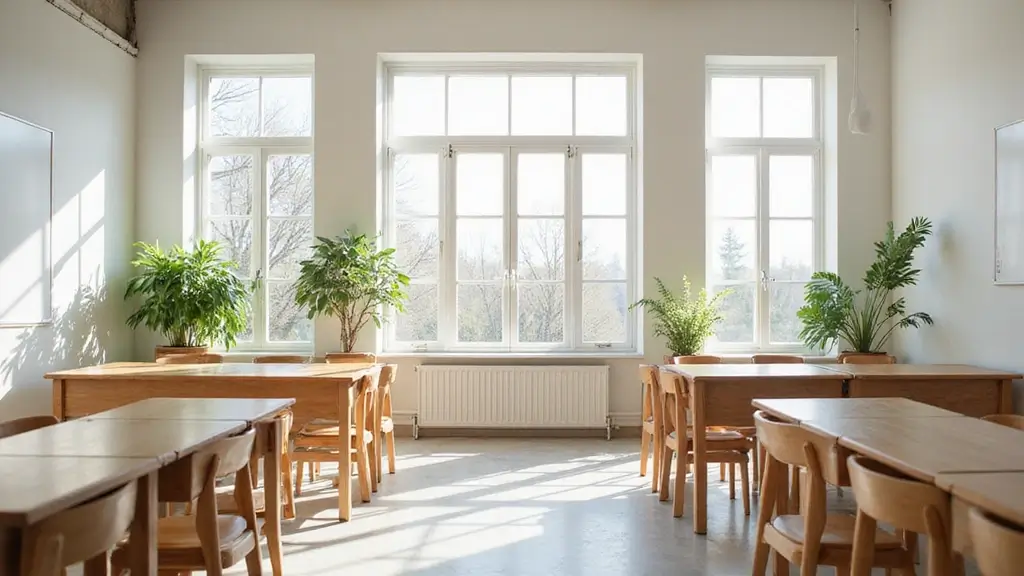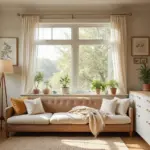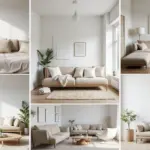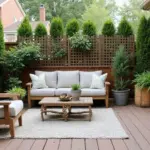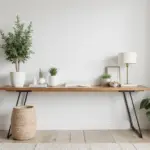Creating a serene, clutter-free learning environment can make all the difference in a classroom.
Minimalist decor can enhance focus and productivity while remaining stylish and functional.
From eco-friendly materials to smart storage solutions, each idea brings a touch of tranquility to educational spaces.
Explore these 27 sustainable minimalist classroom decor ideas that not only beautify the space but also promote a sense of calm and creativity.
1. Natural Wood Accents
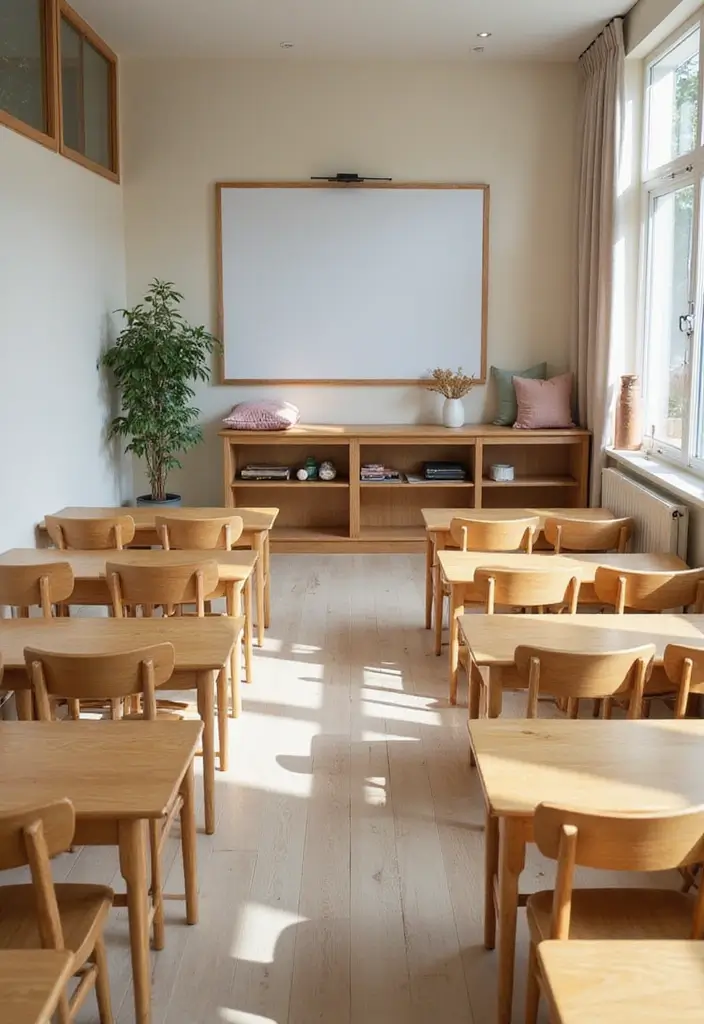
Incorporating natural wood elements can add warmth and comfort to a minimalist classroom.
Think about using wooden shelves, desks, and even seating options when designing your space.
These accents not only promote a modern classroom design but also bring a touch of nature indoors, which can enhance learning.
Consider using reclaimed wood for shelves or tables to boost your sustainable decor.
Pair wooden elements with soft textiles to keep the environment cozy and inviting.
2. Indoor Plants
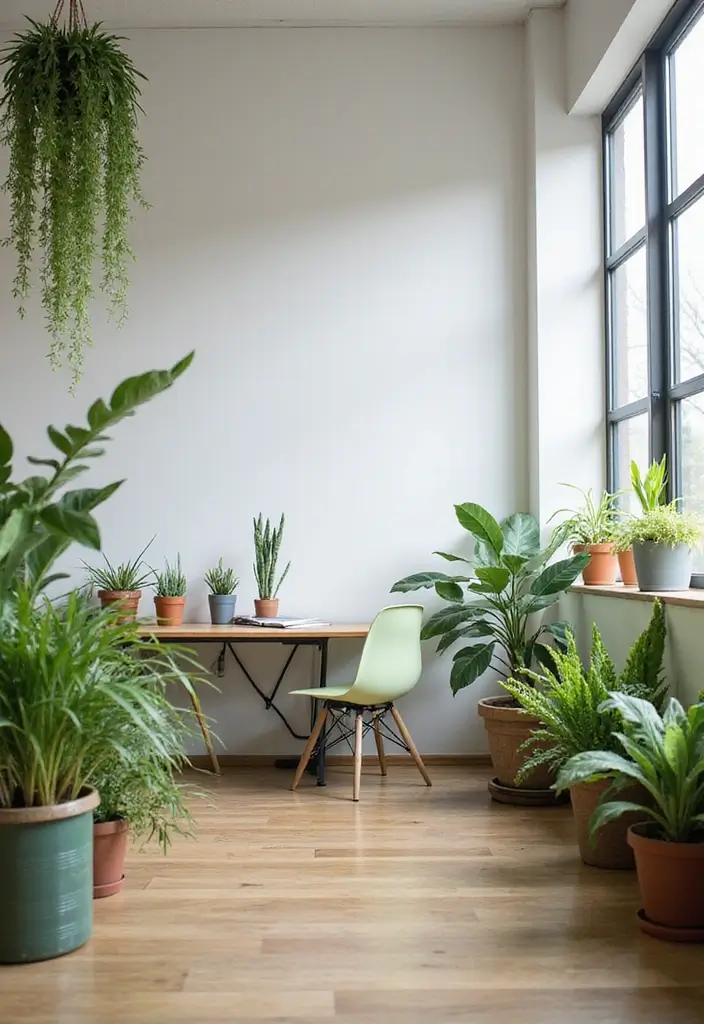
Plants are a fantastic way to breathe life into minimalist educational spaces.
Choose easy-care plants like succulents, snake plants, or pothos that thrive indoors and require little maintenance.
These green friends not only purify the air but also create a calming atmosphere for students.
Place them on windowsills, shelves, or even hang them in planters to maximize space while adding beauty.
Plus, getting students involved in caring for the plants can also teach responsibility and the importance of sustainability.
3. Simple Wall Art
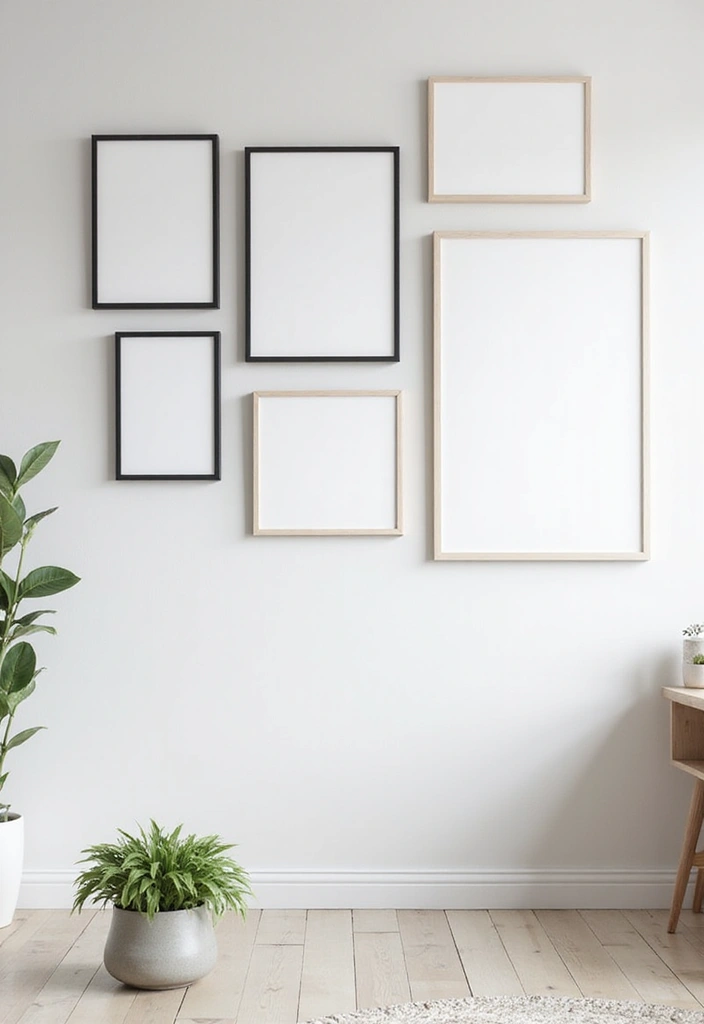
Wall art doesn’t have to be overwhelming.
Opt for simple, abstract prints or monochrome images to keep the vibe minimalist.
Black and white photography or soft, pastel illustrations can serve as inspiration without being distracting.
Create a gallery wall using frames of the same style for a cohesive look.
Consider using removable wall decals that can be easily changed out as themes or seasons change.
Less is more! Elevate your minimalist classroom decor with simple wall art that inspires without overwhelming. A cohesive gallery wall can transform any space into a tranquil learning environment.
4. Modular Furniture
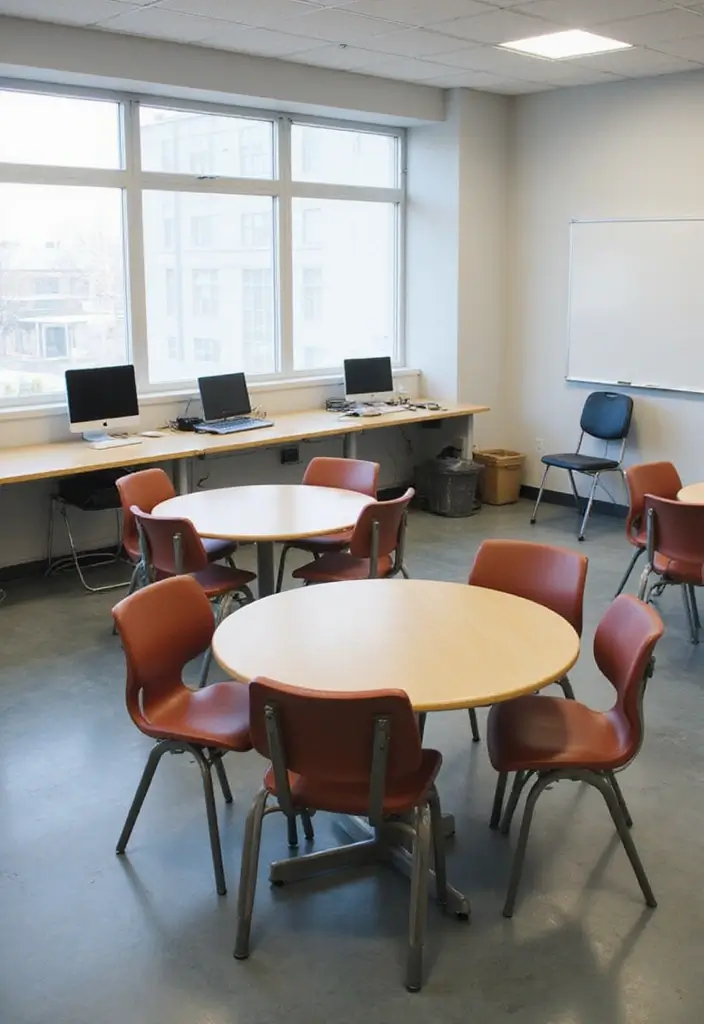
Modular furniture is versatile and perfect for a minimalist approach.
Look for pieces that serve multiple functions; for example, desks that can be rearranged for group activities or storage benches.
This not only enhances functionality but also saves space, making it ideal for smaller classrooms.
Investing in stackable or foldable chairs can free up room for activities while maintaining a sleek appearance.
Remember to choose designs that are both stylish and built to withstand years of use by eager learners.
5. Color Palette Consistency
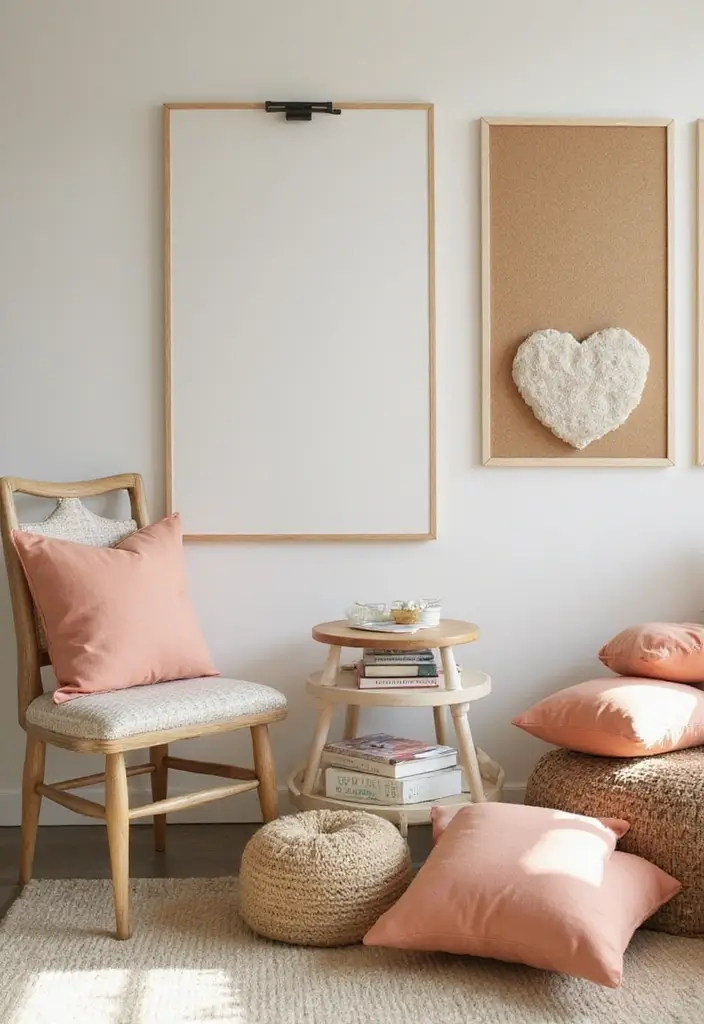
A consistent color palette is vital in minimalist classroom decor.
Selecting just a few colors helps create harmony and avoids visual clutter.
Stick to soft neutrals like whites, grays, and earthy tones, complemented by a few accent colors to keep things fresh.
Use color in your decor items, such as cushions, bulletin boards, and even your book covers.
This approach not only makes the space feel more cohesive and peaceful but also encourages focus on learning materials.
6. Creative Storage Solutions
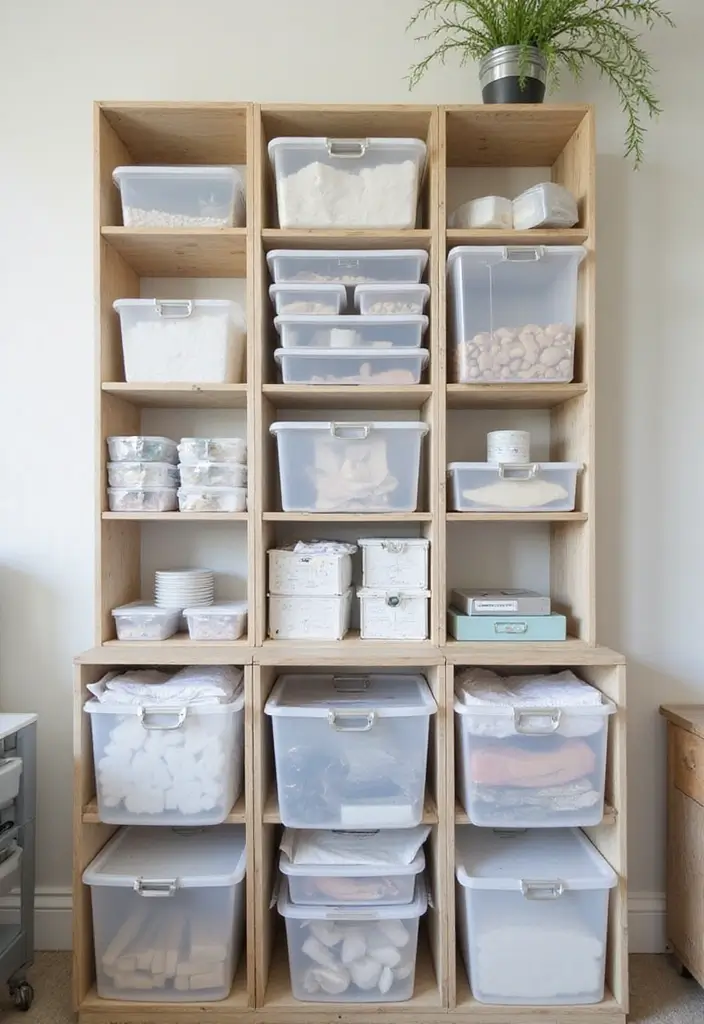
Keeping a minimalist classroom tidy is crucial, and smart storage solutions play a key role.
Utilize clear bins, labeled baskets, and under-desk storage to keep materials organized and accessible.
Open shelving can also be a great way to display educational tools while keeping them within reach.
Encourage students to maintain their own spaces with designated storage for their supplies.
Repurpose items like wooden crates or baskets to add unique character while staying organized.
7. Minimalist Bulletin Boards
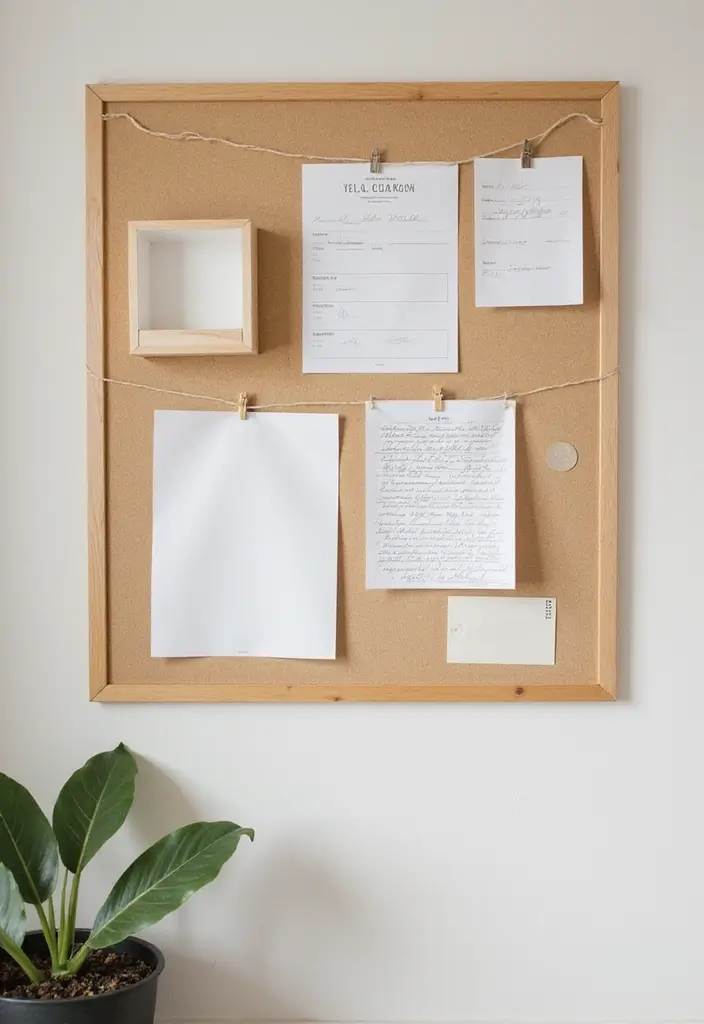
Bulletin boards can often become cluttered, but a minimalist approach keeps them functional and appealing.
Use solid-colored backdrops and limit the number of items displayed to the essentials, like current class projects or important announcements.
Incorporate natural materials such as cork or fabric for a calming effect.
Consider using string and clips to hang student work, allowing for easy swaps and updates without overcrowding.
This helps maintain a sleek look while still showcasing creativity.
8. Functional Teaching Tools
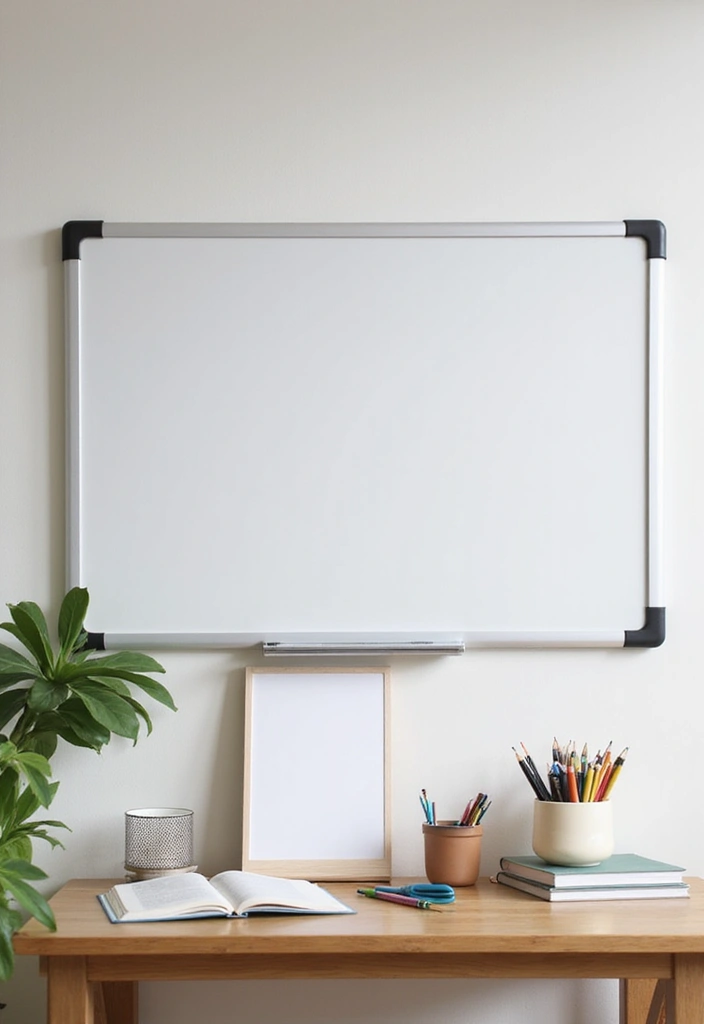
Minimalist teaching tools can enhance the educational experience while reducing clutter.
Choose high-quality, multifunctional materials that serve more than one purpose.
For instance, a dry-erase board that doubles as a projector screen can save space and resources.
Invest in eco-friendly supplies such as bamboo pencils or reusable notebooks to maintain sustainability.
Creating a toolkit of essential teaching resources will simplify your classroom while ensuring everything you need is at hand.
9. Ambient Lighting
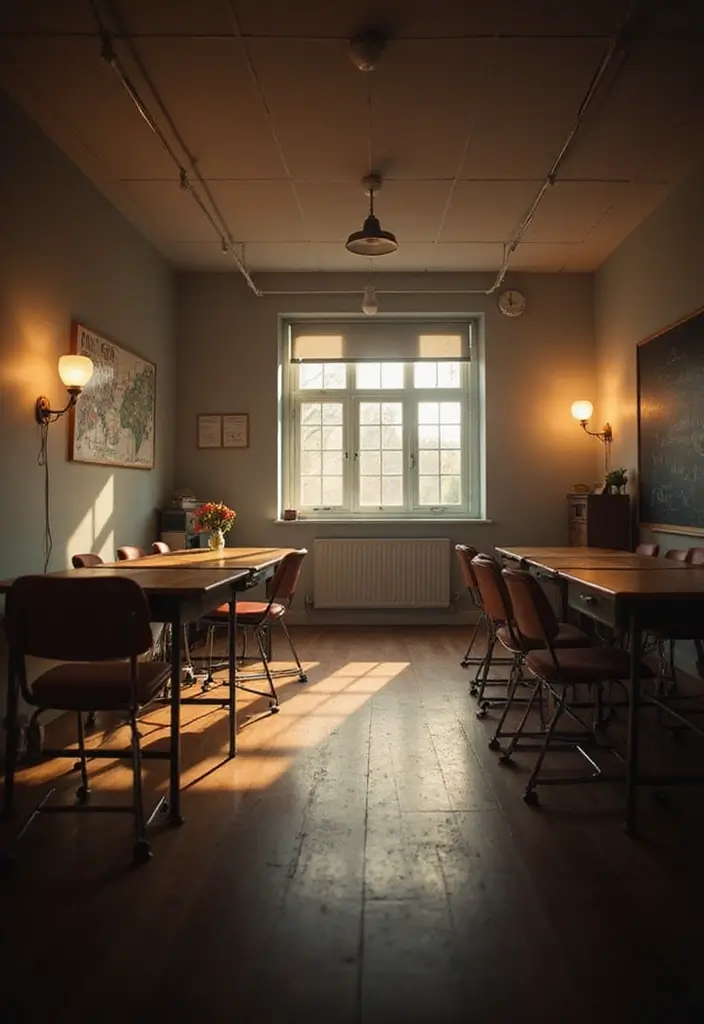
Lighting plays a crucial role in classroom decor and overall mood.
Instead of harsh fluorescent lights, opt for softer, ambient lighting options.
Consider using LED strips under shelves or adding a few standing lamps with warm bulbs to create a more inviting environment.
Natural light is also key; keep window areas open and unobstructed to let in as much daylight as possible.
This can help reduce eye strain and enhance students’ overall comfort throughout their learning experience.
10. Personal Touches
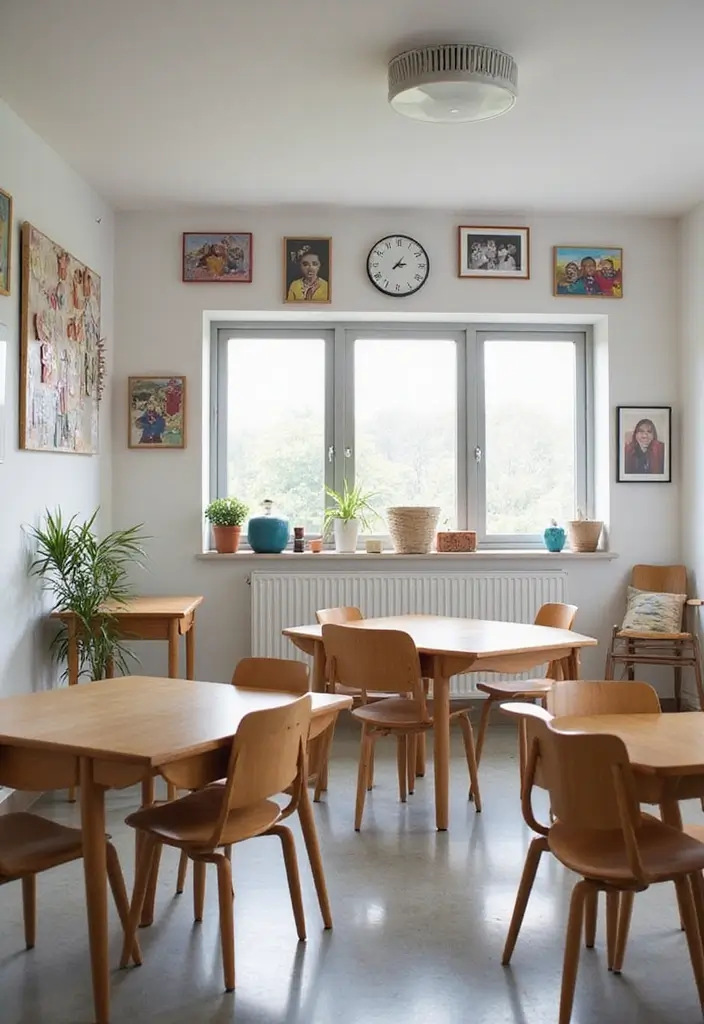
Even within a minimalist framework, personal touches can make a classroom feel more inviting.
Encourage students to contribute to the decor through their artwork or shared projects.
A rotation of student pieces can keep the space dynamic and inclusive, fostering community spirit.
Use photo frames to display memories from class experiences or field trips to personalize the environment.
This approach honors individuality while maintaining the overall minimalist aesthetic.
11. Multi-Use Classrooms
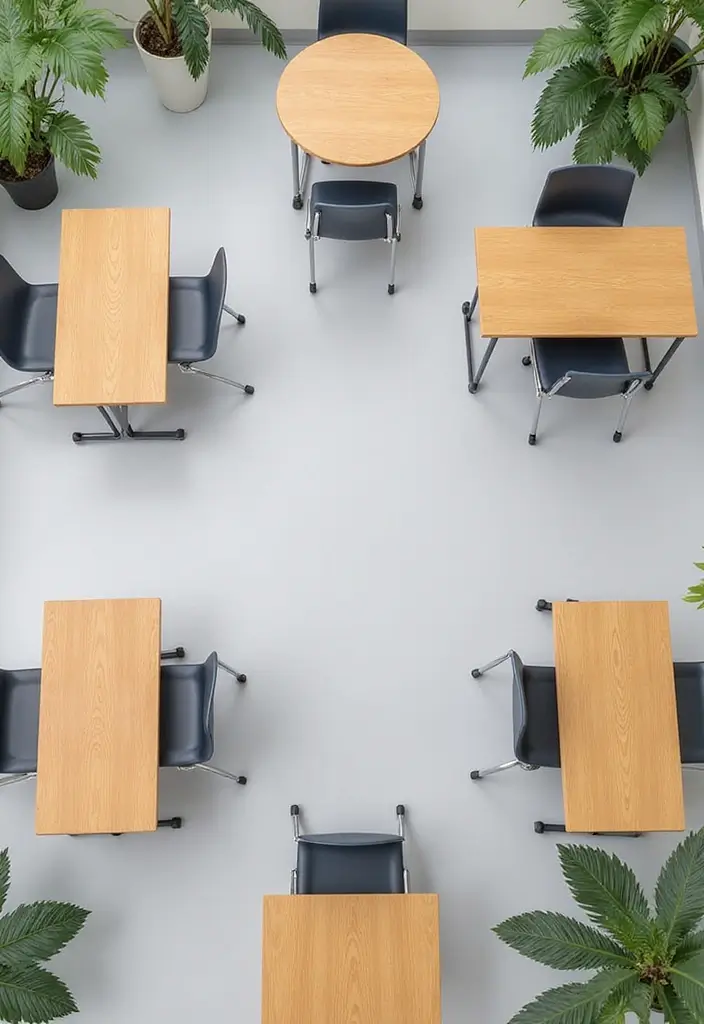
Designing a multi-use classroom can effectively maximize space while maintaining minimalist principles.
Use movable furniture that can be easily rearranged for different activities, such as group work, quiet study, or creative projects.
This flexibility encourages collaboration and keeps the environment fresh and engaging.
Consider incorporating areas for various learning styles, including quiet corners or interactive zones.
This approach not only fosters a love for learning but also adapts to the needs of diverse student groups.
12. Eco-Friendly Materials
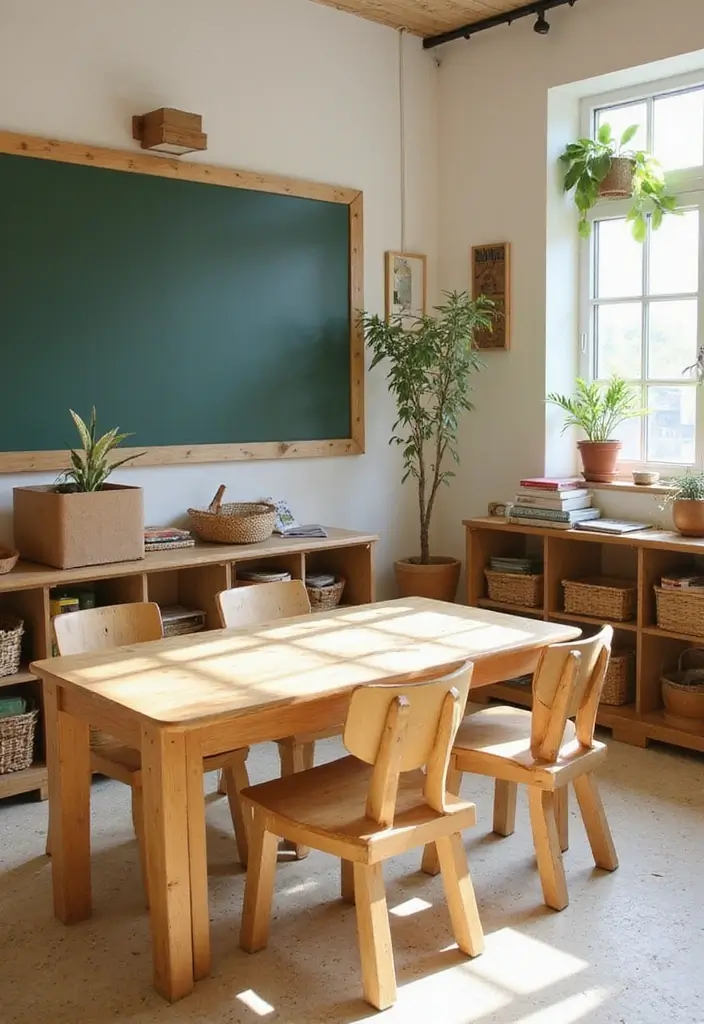
Incorporate eco-friendly materials into your decor to promote sustainability.
Bamboo, recycled cardboard, and biodegradable options are all excellent choices in modern classroom design.
Use materials like cork for bulletin boards or recycled paper for any educational resources.
This not only helps the environment but also teaches students the importance of sustainability and responsibility.
Consider displaying certificates or artwork made from these materials to inspire eco-consciousness.
13. Minimalist Clocks
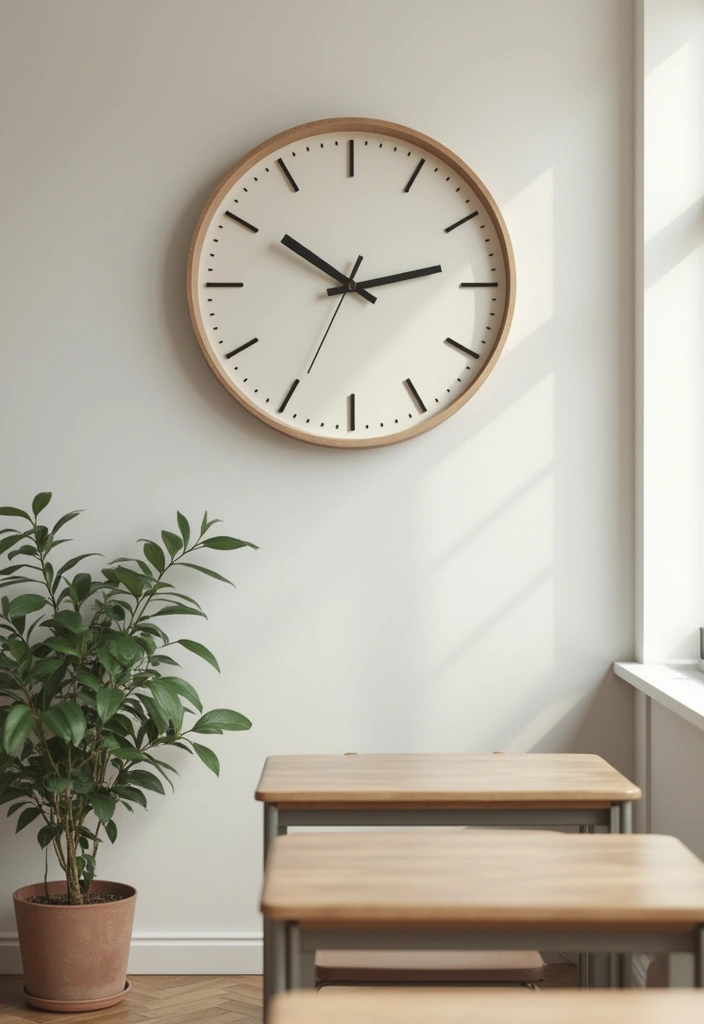
A simple, stylish clock can be both functional and aesthetic.
Choose a minimalist design with clean lines and muted colors that complements the overall classroom decor.
Wall-mounted clocks or desk clocks made from natural materials fit perfectly in a minimalist educational space.
Maintain a focus on time management without distractions from overly bright or loud designs.
Ensure the clock is placed in a visible area for both teachers and students to keep everyone on schedule.
14. Minimalist Desk Accessories
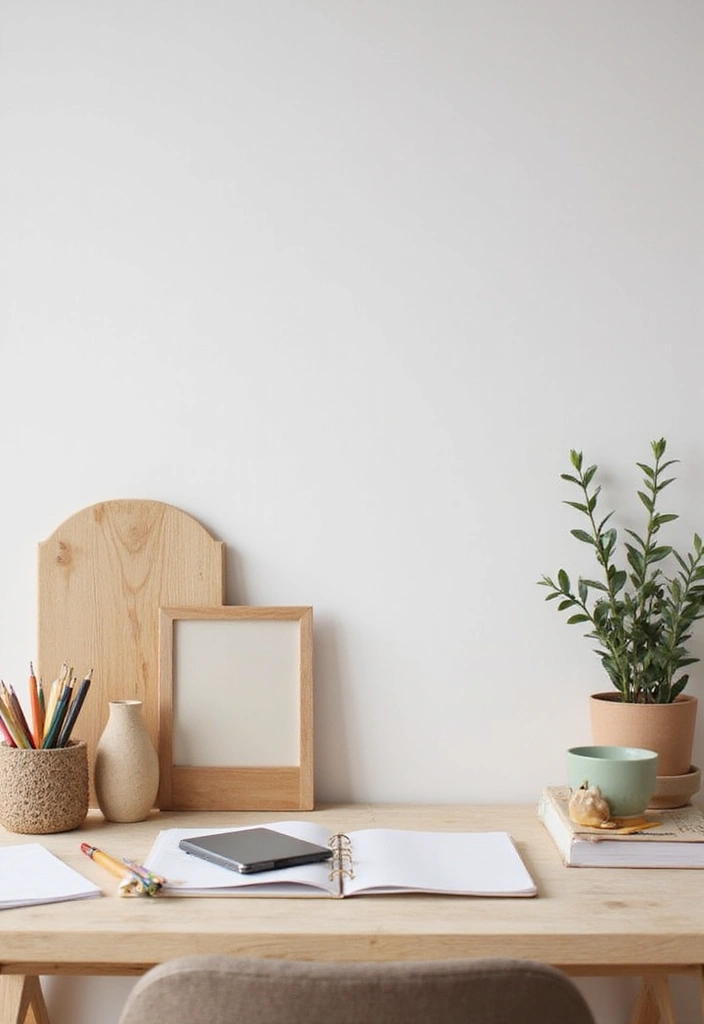
Desk accessories can enhance a minimalist aesthetic while providing functionality.
Opt for simple organizers made from natural materials like wood or metal.
Use muted colors to avoid overwhelming the space, and limit the number of items on display.
Consider utilizing vertical storage for papers and resources, keeping the desk tidy and easy to navigate.
The goal is to create a streamlined workspace that promotes focus and creativity without distraction.
15. Collaborative Spaces
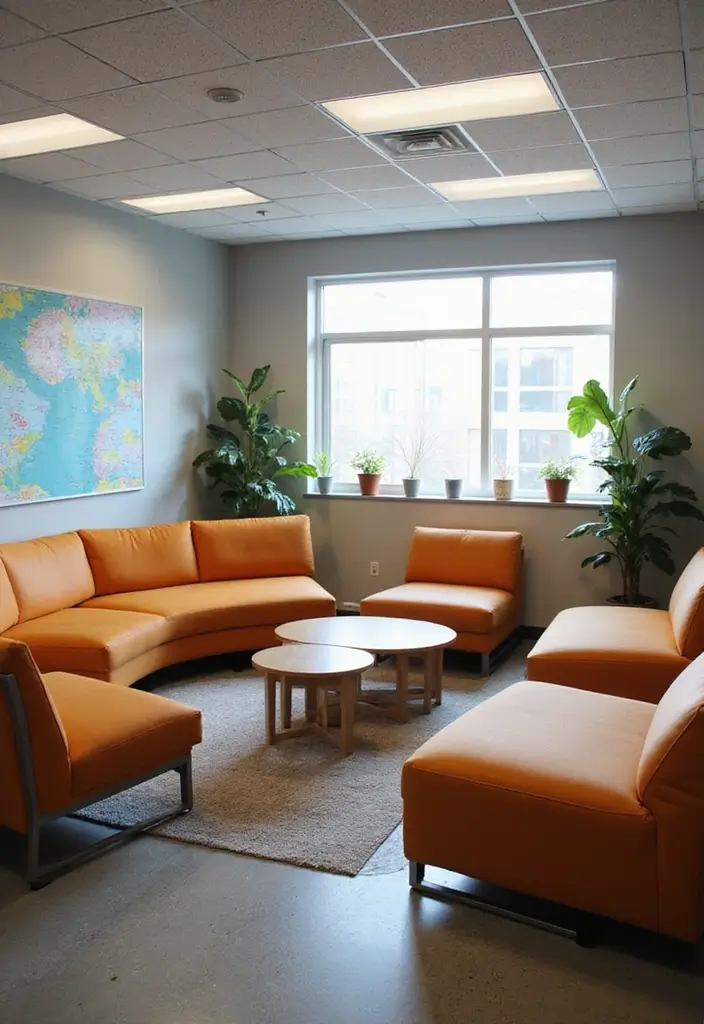
Establishing collaborative spaces within the classroom encourages teamwork and creativity.
Create designated areas with comfortable seating, soft lighting, and flexible furniture that invites groups to gather.
These spaces can be adorned with simple rugs and cushions to create warmth while keeping the area functional.
Ensure the design aligns with the minimalist theme to avoid overcrowding.
This not only fosters collaboration but also makes learning more interactive and enjoyable.
16. Whiteboards and Chalkboards
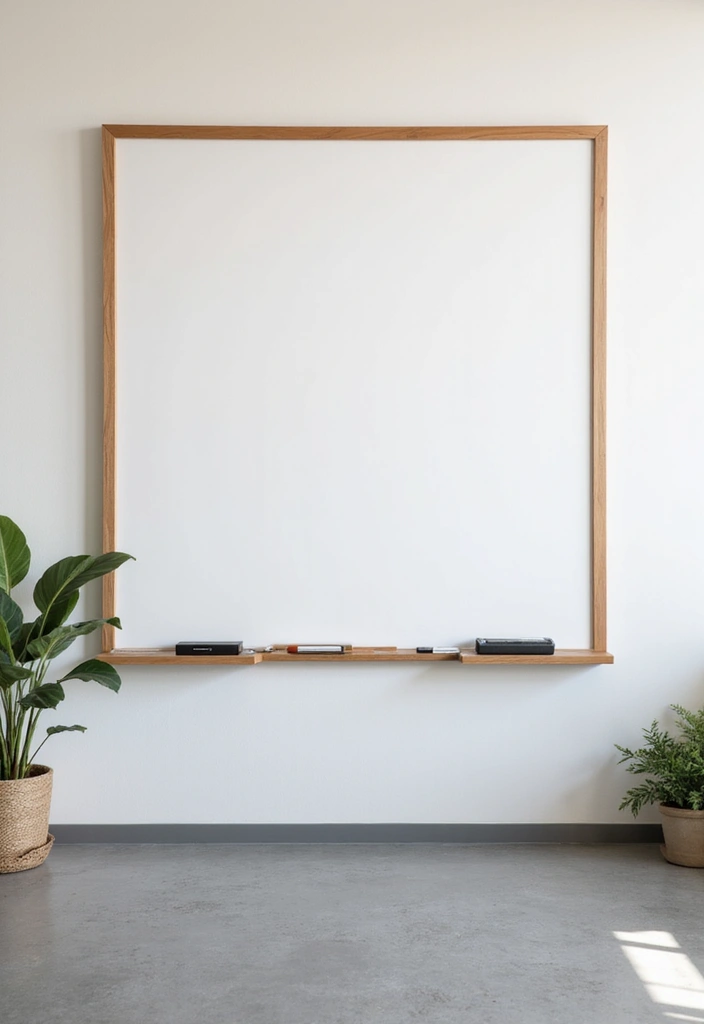
A clean whiteboard or chalkboard is a staple in any classroom, reflecting a minimalist ethos.
Choose a board with a sleek frame that doesn’t overshadow your decor.
Limit the number of written notes or drawings to keep the area tidy, focusing only on the essentials.
For added style, use colored markers or chalk in a limited palette to maintain consistency.
This keeps the boards functional while contributing to the minimalist design.
17. Open Space Layout
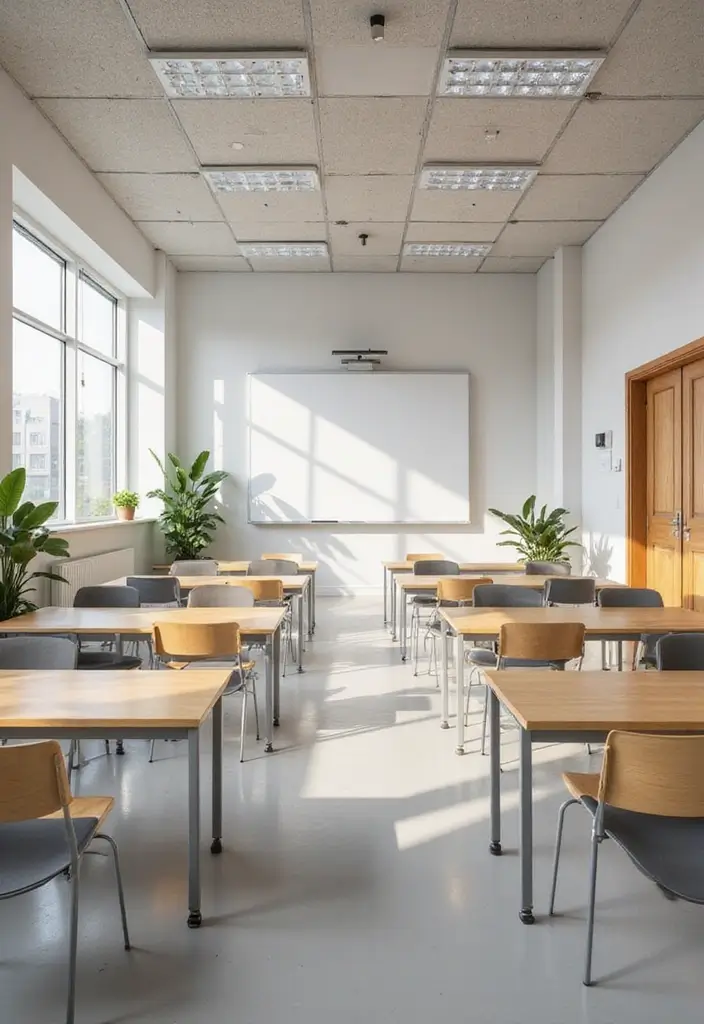
An open space layout promotes movement and creativity while adhering to minimalist principles.
This design allows for flexible seating arrangements and easy transitions between activities.
Avoid overcrowding the space with unnecessary furniture; instead, focus on maintaining open areas for students to move freely.
Utilize multi-purpose furniture to keep the space versatile.
An open layout supports a dynamic learning environment and encourages collaboration among students.
18. Neutral Textiles
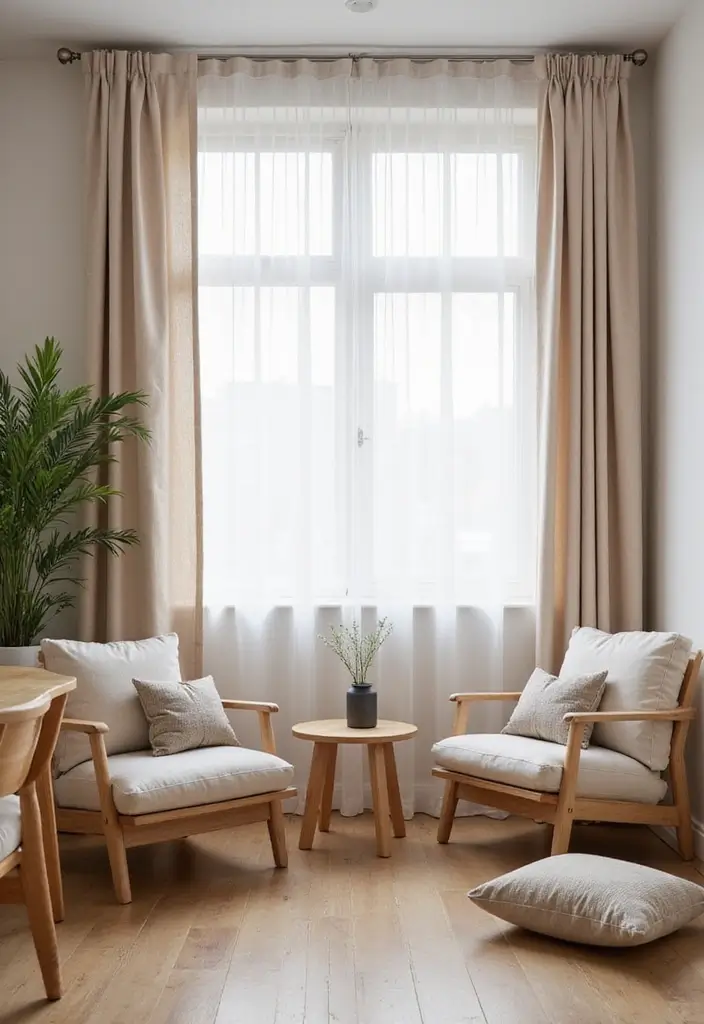
Choosing neutral textiles for curtains, rugs, and cushions enhances a minimalist classroom decor.
Opt for natural fabrics like cotton or linen that breathe and contribute to a serene atmosphere.
Keeping patterns minimal or opting for solid colors helps maintain a cohesive look.
These textiles can soften harsh lines and add comfort without overwhelming the visual space.
Choose machine-washable options for easy maintenance, ensuring a clean and welcoming environment.
19. Understated Rugs
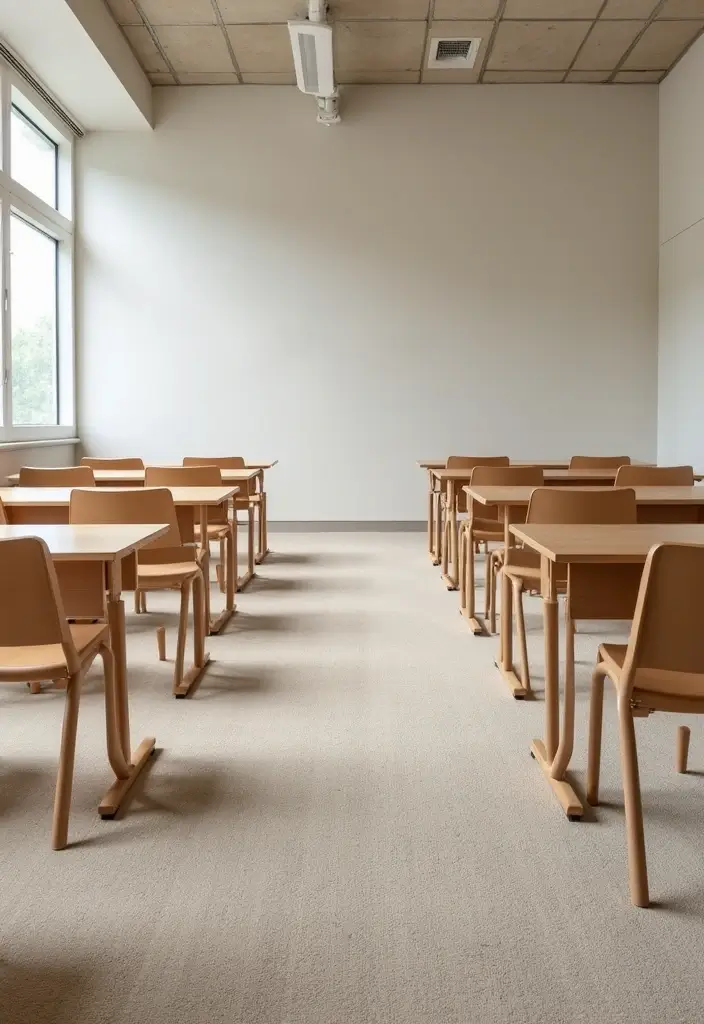
Rugs can enhance comfort while keeping with a minimalist aesthetic when chosen wisely.
Go for understated designs or solid colors that complement the overall decor.
A durable, low-pile rug can define learning areas without being a distraction.
Make sure to choose non-toxic options to maintain a healthy learning environment for students.
Understated rugs can bring warmth while still emphasizing functionality in a minimalist space.
A well-chosen rug doesn’t just ground a space; it elevates a minimalist classroom. Choose non-toxic, low-pile options to keep comfort at the forefront without detracting from your decor.
20. Inspirational Quotes
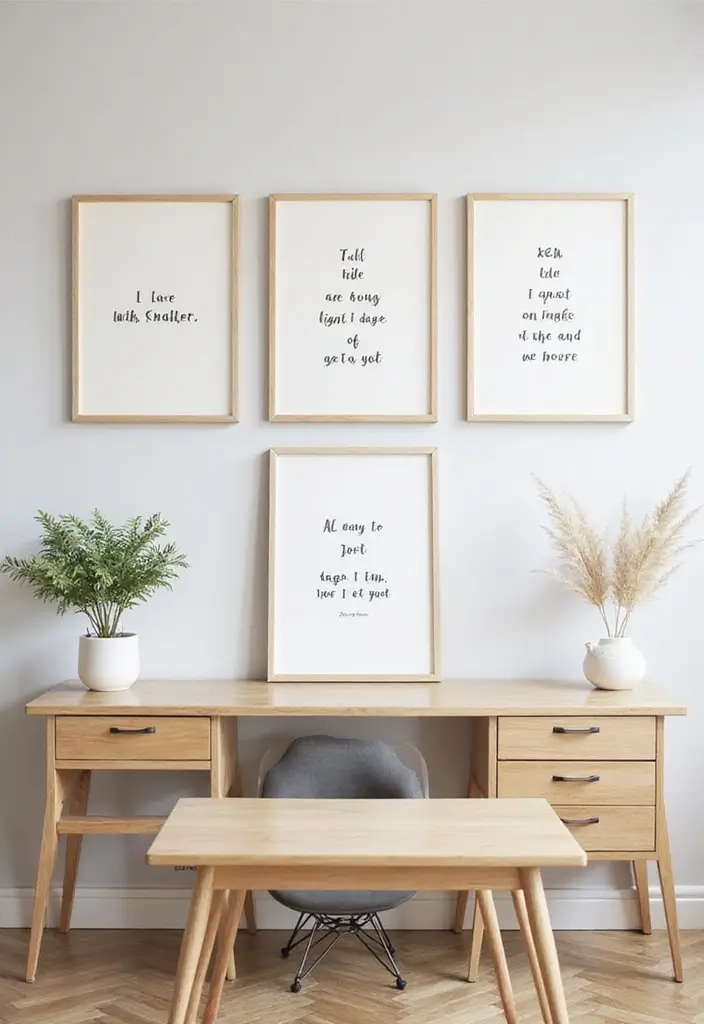
Incorporating inspirational quotes can add motivation without cluttering the space.
Choose simple, meaningful phrases displayed in clean typography.
Using frames or canvas prints in neutral tones helps keep the focus on the message rather than the design.
Consider rotating quotes to keep the content fresh and relevant.
This approach inspires students without overwhelming the minimalist aesthetic.
“Minimalist classroom decor amplifies the power of words. Choose impactful quotes that breathe inspiration into your space, reminding students to dream big without the distraction of clutter.”
21. Mindful Seating Arrangements
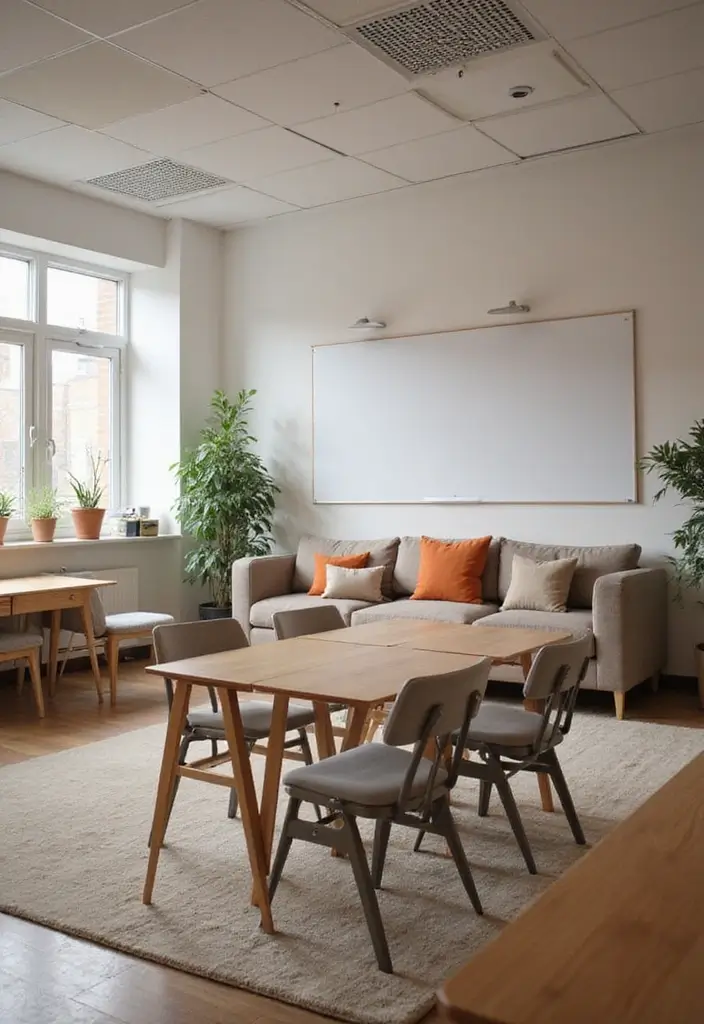
Mindful seating arrangements can transform the classroom environment.
Consider using different types of seating to create areas for focused work and collaborative discussions.
Soft floor seating, such as bean bags or cushions, can encourage relaxation and creativity, while traditional desks can be arranged for structured lessons.
This balance maintains the minimalist feel while supporting various learning styles.
Ensure the seating is comfortable yet simple, avoiding overly ornate designs.
22. Smart Technology Integration
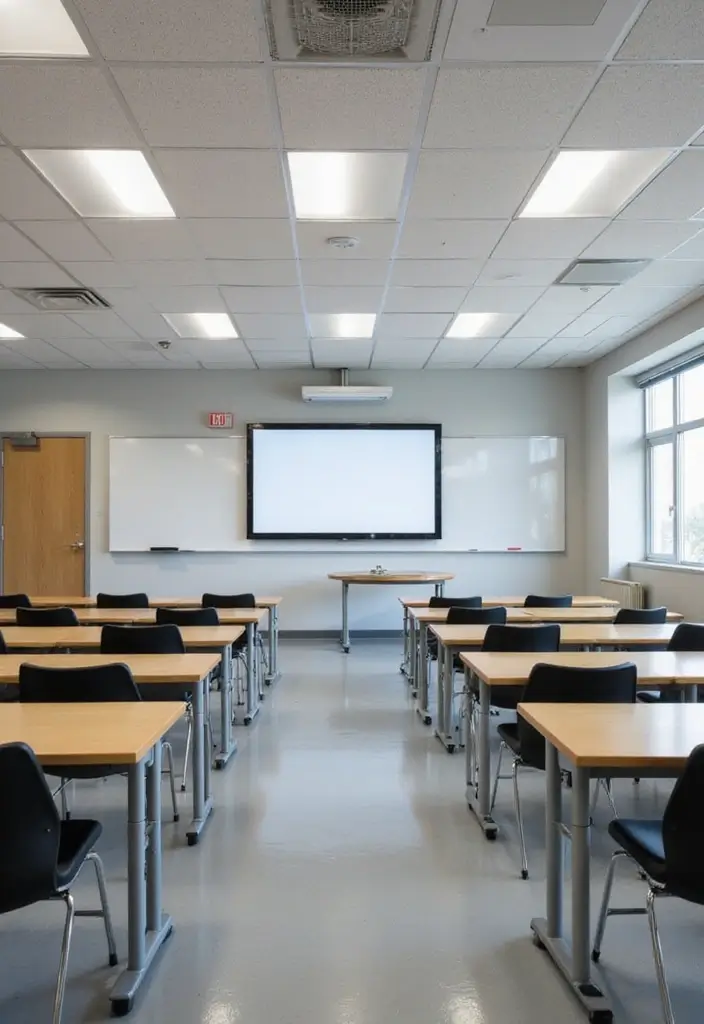
Incorporating smart technology into your classroom can enhance learning while keeping decor minimal.
Choose devices that save space, such as projectors that can be mounted or smartboards that combine multiple functions.
Hide wires and equipment within furniture or use cable management solutions to maintain a clean look.
This ensures that the technology serves its purpose without detracting from the room’s aesthetic.
The fusion of tech and minimalist design can create an engaging educational environment.
23. Statement Piece Furniture
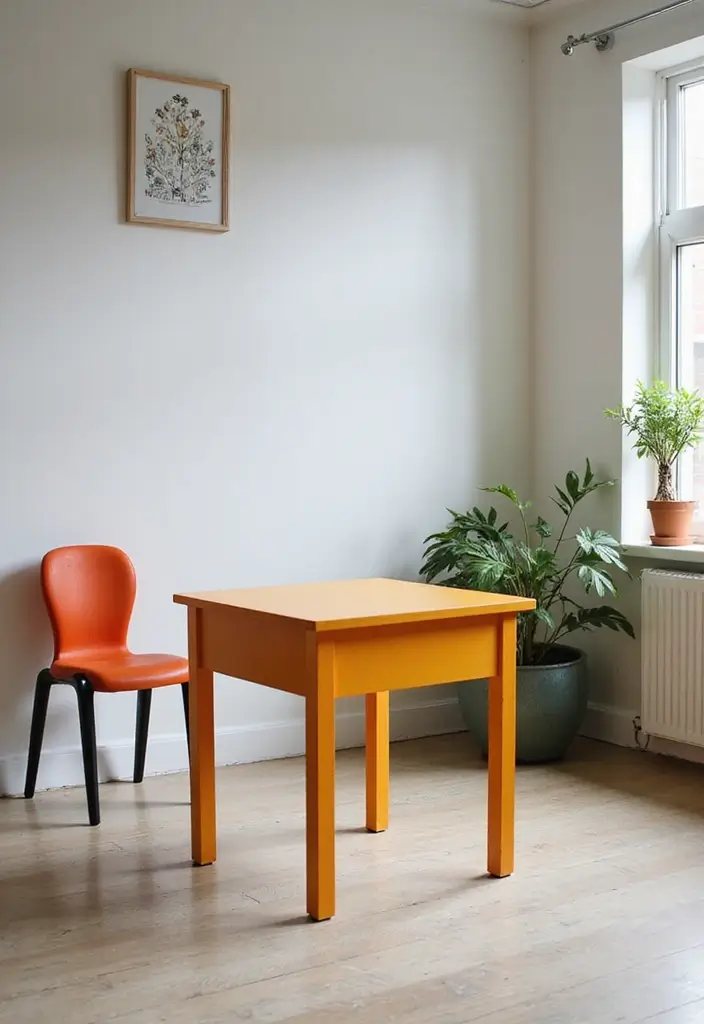
A single statement piece can anchor a minimalist classroom and provide a focal point.
Consider a unique chair, a bold-colored desk, or an artistic shelf that stands out against neutral backdrops.
This piece should be thoughtfully chosen to enhance the aesthetic without overwhelming the space.
Make sure it’s functional as well as visually appealing, contributing to the overall educational experience.
Statement pieces can invite conversations and stimulate creativity in students.
24. Clear Desk Policy
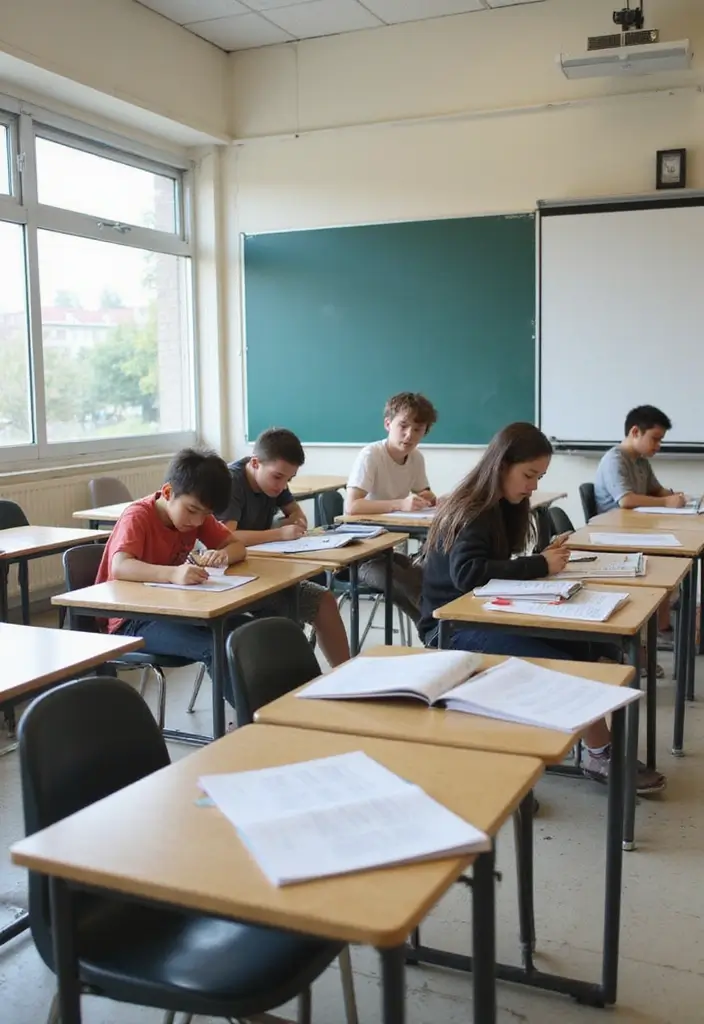
Encouraging a clear desk policy can significantly enhance a minimalist classroom.
Promote the idea of keeping only essential items on desks to foster focus and clarity.
Introduce storage solutions that allow students to easily tuck away unnecessary materials.
This practice not only cultivates a clean learning environment but also teaches responsibility and organization.
Regularly revisit the policy and celebrate students who maintain a tidy space.
25. Annual Redecorating
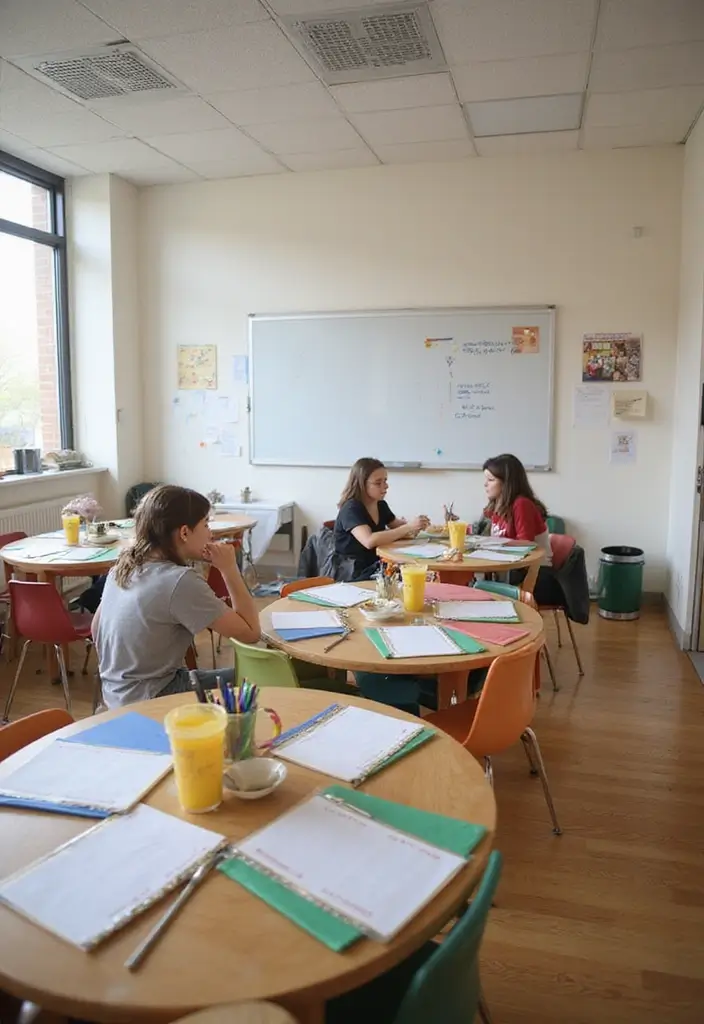
Consider having an annual redecorating event to refresh the classroom decor.
This allows for a clean slate and gives students a sense of ownership over their space.
Involve students in choosing new colors, themes, or decor items that align with minimalism.
This approach fosters creativity and engages students in the upkeep of their environment.
Plus, it keeps the classroom feeling vibrant and inviting throughout the year.
26. Interactive Whiteboard Walls
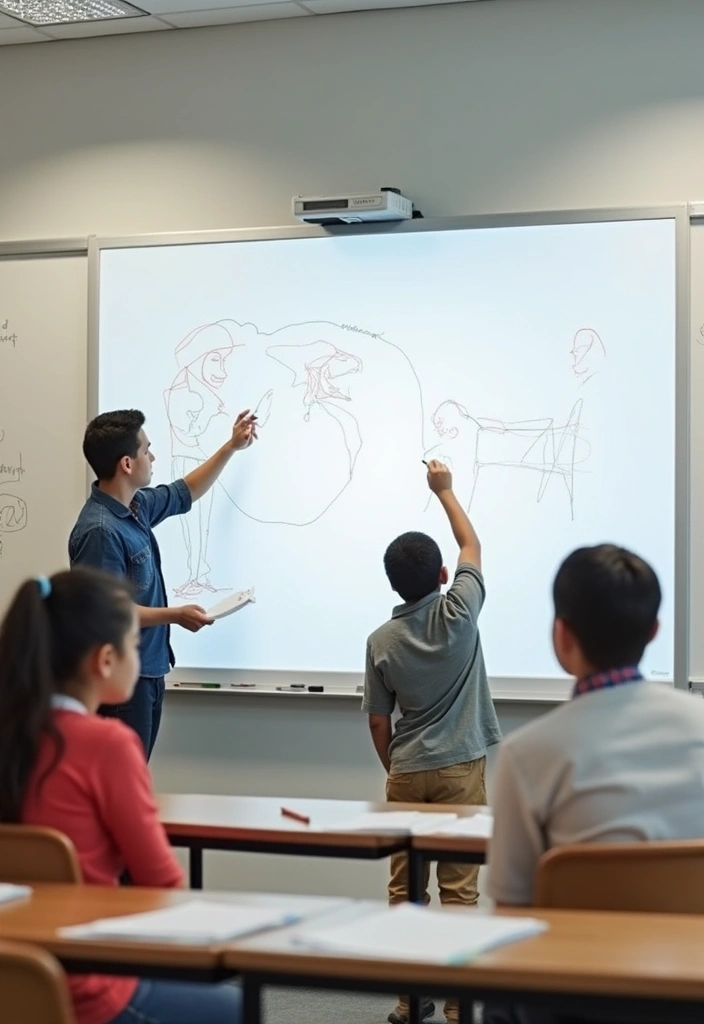
Transform a wall into an interactive whiteboard space to enhance learning dynamics.
This minimalist approach encourages creativity and collaboration among students.
Use erasable paint or films that allow for easy writing and erasing without damaging the wall.
This not only serves the function of a traditional board but also adds a unique element to the room.
The result is a stylish, functional area that promotes active participation and engagement.
An interactive whiteboard wall is more than just a board; it’s a canvas for creativity and collaboration! Transform your classroom into a minimalist hub of engagement where every student can leave their mark.
27. Student-Centered Displays
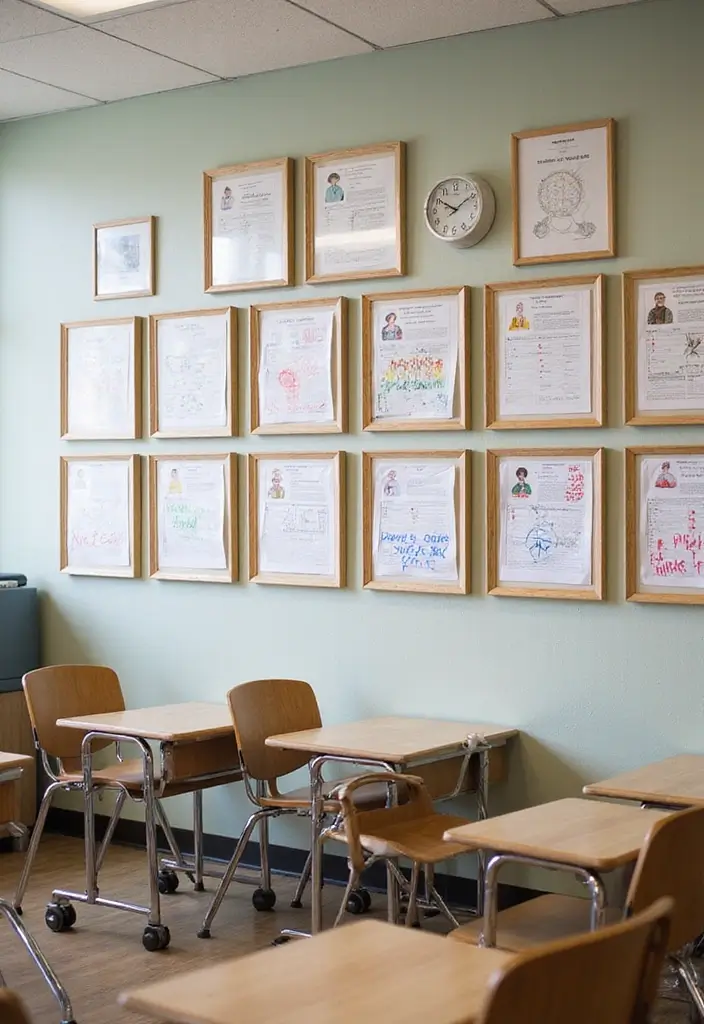
Finally, student-centered displays personalizes the classroom while maintaining a minimalist feel.
Rotate student projects or work displays to allow for fresh content without overcrowding the walls.
Use simple, uniform frames to showcase work in a cohesive manner.
This not only motivates students but also fosters a sense of pride in their contributions.
Keep the displays organized and themed to prevent a chaotic appearance.
Conclusion
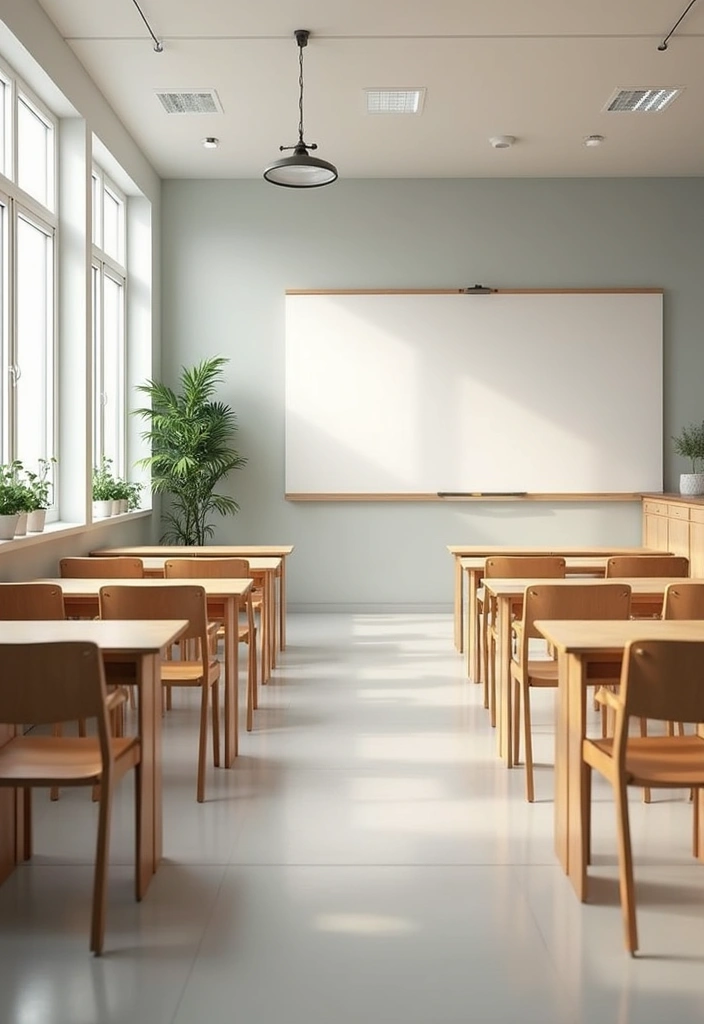
Creating a minimalist classroom doesn’t mean sacrificing style for function.
The ideas shared here illustrate how you can design an educational space that is both beautiful and conducive to learning.
Invite students into the process and watch how a thoughtful environment enhances their experience.
Frequently Asked Questions
What Are the Key Benefits of Minimalist Classroom Decor?
Minimalist classroom decor can significantly enhance the learning environment by promoting focus and productivity. A clutter-free space reduces distractions, allowing students to concentrate better on their studies. Additionally, a minimalist aesthetic creates a calming atmosphere that can make students feel more relaxed and open to learning.
By incorporating simple decor ideas, you can foster an educational space that’s both functional and visually appealing, ultimately benefiting both teachers and students.
How Can I Incorporate Eco-Friendly Materials in My Classroom Decor?
Incorporating eco-friendly materials into your minimalist classroom decor is easier than you might think! Consider using sustainable options like bamboo furniture, recycled cardboard displays, and biodegradable textiles. Not only do these choices support the environment, but they also contribute to a modern classroom design that aligns with minimalist principles.
Look for local suppliers that specialize in sustainable products, and involve students in the selection process to make it even more engaging!
What Are Some Simple Storage Solutions for a Minimalist Classroom?
Keeping a minimalist classroom tidy is essential, and effective storage solutions can help you achieve that. Utilize clear bins for visibility, labeled baskets for organization, and under-desk storage to minimize clutter. These practical tools ensure that materials are accessible while maintaining a clean and functional aesthetic.
Encourage a ‘less is more’ philosophy by regularly assessing what items are essential and what can be removed or stored away.
How Can I Personalize My Minimalist Classroom Without Overcrowding?
Personal touches in a minimalist classroom can be both meaningful and unobtrusive. Consider featuring student-centered displays that rotate regularly, showcasing individual projects or artwork. This keeps the decor fresh and allows students to feel ownership of their space while adhering to minimalism principles.
Incorporating inspirational quotes in simple typography can also add motivation without overwhelming the decor. Choose neutral-toned frames to maintain harmony throughout the classroom.
What Furniture Works Best for a Minimalist Classroom Design?
When designing a minimalist classroom, opt for modular furniture that offers versatility. Pieces that can be rearranged for different activities or serve multiple functions—like storage benches or collapsible desks—are perfect. Additionally, choose furniture with clean lines and muted colors to stay true to the minimalist aesthetic.
Remember, the goal is to create a functional space that encourages creativity and collaboration while remaining stylish!
Related Topics
minimalist classroom decor
sustainable design
modern classroom design
simple decor ideas
functional aesthetics
eco-friendly materials
creative storage solutions
modular furniture
neutral textiles
student-centered displays
ambient lighting
mindful seating arrangements

